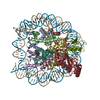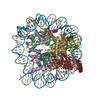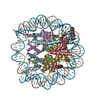[English] 日本語
 Yorodumi
Yorodumi- PDB-8x7k: Cryo-EM structures of RNF168/UbcH5c-Ub in complex with H2AK13Ub n... -
+ Open data
Open data
- Basic information
Basic information
| Entry | Database: PDB / ID: 8x7k | ||||||||||||||||||||||||||||||
|---|---|---|---|---|---|---|---|---|---|---|---|---|---|---|---|---|---|---|---|---|---|---|---|---|---|---|---|---|---|---|---|
| Title | Cryo-EM structures of RNF168/UbcH5c-Ub in complex with H2AK13Ub nucleosomes determined by activity-based chemical trapping strategy (adjacent H2AK13/15 dual-monoubiquitination) | ||||||||||||||||||||||||||||||
 Components Components |
| ||||||||||||||||||||||||||||||
 Keywords Keywords | NUCLEAR PROTEIN/DNA / RNF168 / nucleosome / H2AK13/15 ubiquitination / NUCLEAR PROTEIN / NUCLEAR PROTEIN-DNA complex | ||||||||||||||||||||||||||||||
| Function / homology |  Function and homology information Function and homology informationhistone H2AK15 ubiquitin ligase activity / histone ubiquitin ligase activity / protein K6-linked ubiquitination / Signaling by BMP / (E3-independent) E2 ubiquitin-conjugating enzyme / double-strand break repair via classical nonhomologous end joining / isotype switching / protein K11-linked ubiquitination / positive regulation of protein targeting to mitochondrion / E2 ubiquitin-conjugating enzyme ...histone H2AK15 ubiquitin ligase activity / histone ubiquitin ligase activity / protein K6-linked ubiquitination / Signaling by BMP / (E3-independent) E2 ubiquitin-conjugating enzyme / double-strand break repair via classical nonhomologous end joining / isotype switching / protein K11-linked ubiquitination / positive regulation of protein targeting to mitochondrion / E2 ubiquitin-conjugating enzyme / K63-linked polyubiquitin modification-dependent protein binding / response to ionizing radiation / DNA repair-dependent chromatin remodeling / ubiquitin conjugating enzyme activity / negative regulation of transcription elongation by RNA polymerase II / negative regulation of BMP signaling pathway / protein K63-linked ubiquitination / protein monoubiquitination / ubiquitin ligase complex / negative regulation of megakaryocyte differentiation / interstrand cross-link repair / protein localization to CENP-A containing chromatin / SUMOylation of DNA damage response and repair proteins / protein K48-linked ubiquitination / Chromatin modifying enzymes / Replacement of protamines by nucleosomes in the male pronucleus / CENP-A containing nucleosome / nucleosome binding / protein autoubiquitination / Packaging Of Telomere Ends / Recognition and association of DNA glycosylase with site containing an affected purine / Cleavage of the damaged purine / Recognition and association of DNA glycosylase with site containing an affected pyrimidine / Cleavage of the damaged pyrimidine / Deposition of new CENPA-containing nucleosomes at the centromere / telomere organization / Inhibition of DNA recombination at telomere / Meiotic synapsis / Interleukin-7 signaling / RNA Polymerase I Promoter Opening / Assembly of the ORC complex at the origin of replication / Regulation of endogenous retroelements by the Human Silencing Hub (HUSH) complex / SUMOylation of chromatin organization proteins / positive regulation of DNA repair / DNA methylation / Condensation of Prophase Chromosomes / TICAM1, RIP1-mediated IKK complex recruitment / Chromatin modifications during the maternal to zygotic transition (MZT) / HCMV Late Events / SIRT1 negatively regulates rRNA expression / epigenetic regulation of gene expression / ERCC6 (CSB) and EHMT2 (G9a) positively regulate rRNA expression / ubiquitin binding / chloroplast / PRC2 methylates histones and DNA / IKK complex recruitment mediated by RIP1 / PINK1-PRKN Mediated Mitophagy / Regulation of endogenous retroelements by KRAB-ZFP proteins / Defective pyroptosis / Regulation of endogenous retroelements by Piwi-interacting RNAs (piRNAs) / HDACs deacetylate histones / Negative regulators of DDX58/IFIH1 signaling / Nonhomologous End-Joining (NHEJ) / RNA Polymerase I Promoter Escape / Peroxisomal protein import / Regulation of TNFR1 signaling / Transcriptional regulation by small RNAs / Downregulation of SMAD2/3:SMAD4 transcriptional activity / Formation of the beta-catenin:TCF transactivating complex / RUNX1 regulates genes involved in megakaryocyte differentiation and platelet function / Activated PKN1 stimulates transcription of AR (androgen receptor) regulated genes KLK2 and KLK3 / G2/M DNA damage checkpoint / HDMs demethylate histones / Inactivation of CSF3 (G-CSF) signaling / NoRC negatively regulates rRNA expression / RING-type E3 ubiquitin transferase / protein modification process / DNA Damage/Telomere Stress Induced Senescence / B-WICH complex positively regulates rRNA expression / Oxygen-dependent proline hydroxylation of Hypoxia-inducible Factor Alpha / PKMTs methylate histone lysines / Meiotic recombination / Pre-NOTCH Transcription and Translation / double-strand break repair via nonhomologous end joining / Metalloprotease DUBs / RMTs methylate histone arginines / Activation of anterior HOX genes in hindbrain development during early embryogenesis / Transcriptional regulation of granulopoiesis / HCMV Early Events / protein polyubiquitination / ubiquitin-protein transferase activity / structural constituent of chromatin / UCH proteinases / ubiquitin protein ligase activity / nucleosome / Antigen processing: Ubiquitination & Proteasome degradation / heterochromatin formation / double-strand break repair / E3 ubiquitin ligases ubiquitinate target proteins / nucleosome assembly Similarity search - Function | ||||||||||||||||||||||||||||||
| Biological species |  Homo sapiens (human) Homo sapiens (human) | ||||||||||||||||||||||||||||||
| Method | ELECTRON MICROSCOPY / single particle reconstruction / cryo EM / Resolution: 3.27 Å | ||||||||||||||||||||||||||||||
 Authors Authors | Ai, H.S. / Tong, Z.B. / Deng, Z.H. / Pan, M. / Liu, L. | ||||||||||||||||||||||||||||||
| Funding support |  China, 1items China, 1items
| ||||||||||||||||||||||||||||||
 Citation Citation |  Journal: Biorxiv / Year: 2024 Journal: Biorxiv / Year: 2024Title: Capturing Snapshots of Nucleosomal H2A K13/K15 Ubiquitination Mediated by the Monomeric E3 Ligase RNF168 Authors: Ai, H. / Tong, Z. / Deng, Z. / Shi, Q. / Tao, S. / Liang, J. / Sun, M. / Wu, X. / Zheng, Q. / Liang, L. / Li, J.B. / Gao, S. / Tian, C. / Liu, L. / Pan, M. | ||||||||||||||||||||||||||||||
| History |
|
- Structure visualization
Structure visualization
| Structure viewer | Molecule:  Molmil Molmil Jmol/JSmol Jmol/JSmol |
|---|
- Downloads & links
Downloads & links
- Download
Download
| PDBx/mmCIF format |  8x7k.cif.gz 8x7k.cif.gz | 327.9 KB | Display |  PDBx/mmCIF format PDBx/mmCIF format |
|---|---|---|---|---|
| PDB format |  pdb8x7k.ent.gz pdb8x7k.ent.gz | 245.8 KB | Display |  PDB format PDB format |
| PDBx/mmJSON format |  8x7k.json.gz 8x7k.json.gz | Tree view |  PDBx/mmJSON format PDBx/mmJSON format | |
| Others |  Other downloads Other downloads |
-Validation report
| Arichive directory |  https://data.pdbj.org/pub/pdb/validation_reports/x7/8x7k https://data.pdbj.org/pub/pdb/validation_reports/x7/8x7k ftp://data.pdbj.org/pub/pdb/validation_reports/x7/8x7k ftp://data.pdbj.org/pub/pdb/validation_reports/x7/8x7k | HTTPS FTP |
|---|
-Related structure data
| Related structure data |  38101MC  8x7iC  8x7jC M: map data used to model this data C: citing same article ( |
|---|---|
| Similar structure data | Similarity search - Function & homology  F&H Search F&H Search |
- Links
Links
- Assembly
Assembly
| Deposited unit | 
|
|---|---|
| 1 |
|
- Components
Components
-Protein , 5 types, 8 molecules AEBFDHKL
| #1: Protein | Mass: 11401.268 Da / Num. of mol.: 2 Source method: isolated from a genetically manipulated source Source: (gene. exp.)  Homo sapiens (human) Homo sapiens (human)Gene: H3C15, HIST2H3A, H3C14, H3F2, H3FM, HIST2H3C, H3C13, HIST2H3D Production host:  #2: Protein | Mass: 9352.003 Da / Num. of mol.: 2 Source method: isolated from a genetically manipulated source Source: (gene. exp.)  Homo sapiens (human) Homo sapiens (human)Gene: H4C1, H4/A, H4FA, HIST1H4A, H4C2, H4/I, H4FI, HIST1H4B, H4C3, H4/G, H4FG, HIST1H4C, H4C4, H4/B, H4FB, HIST1H4D, H4C5, H4/J, H4FJ, HIST1H4E, H4C6, H4/C, H4FC, HIST1H4F, H4C8, H4/H, H4FH, ...Gene: H4C1, H4/A, H4FA, HIST1H4A, H4C2, H4/I, H4FI, HIST1H4B, H4C3, H4/G, H4FG, HIST1H4C, H4C4, H4/B, H4FB, HIST1H4D, H4C5, H4/J, H4FJ, HIST1H4E, H4C6, H4/C, H4FC, HIST1H4F, H4C8, H4/H, H4FH, HIST1H4H, H4C9, H4/M, H4FM, HIST1H4I, H4C11, H4/E, H4FE, HIST1H4J, H4C12, H4/D, H4FD, HIST1H4K, H4C13, H4/K, H4FK, HIST1H4L, H4C14, H4/N, H4F2, H4FN, HIST2H4, HIST2H4A, H4C15, H4/O, H4FO, HIST2H4B, H4C16, H4-16, HIST4H4 Production host:  #4: Protein | Mass: 10477.994 Da / Num. of mol.: 2 Source method: isolated from a genetically manipulated source Source: (gene. exp.)  Homo sapiens (human) / Gene: H2BC12, H2BFT, HIRIP1, HIST1H2BK / Production host: Homo sapiens (human) / Gene: H2BC12, H2BFT, HIRIP1, HIST1H2BK / Production host:  #8: Protein | | Mass: 16657.938 Da / Num. of mol.: 1 Source method: isolated from a genetically manipulated source Source: (gene. exp.)  Homo sapiens (human) / Gene: UBE2D3, UBC5C, UBCH5C / Production host: Homo sapiens (human) / Gene: UBE2D3, UBC5C, UBCH5C / Production host:  References: UniProt: P61077, E2 ubiquitin-conjugating enzyme, (E3-independent) E2 ubiquitin-conjugating enzyme #9: Protein | | Mass: 12987.123 Da / Num. of mol.: 1 Source method: isolated from a genetically manipulated source Source: (gene. exp.)  Homo sapiens (human) / Gene: RNF168 / Production host: Homo sapiens (human) / Gene: RNF168 / Production host:  References: UniProt: Q8IYW5, RING-type E3 ubiquitin transferase |
|---|
-Histone H2A type 1- ... , 2 types, 2 molecules CG
| #3: Protein | Mass: 11482.382 Da / Num. of mol.: 1 Source method: isolated from a genetically manipulated source Source: (gene. exp.)  Homo sapiens (human) / Gene: H2AC4, H2AFM, HIST1H2AB, H2AC8, H2AFA, HIST1H2AE / Production host: Homo sapiens (human) / Gene: H2AC4, H2AFM, HIST1H2AB, H2AC8, H2AFA, HIST1H2AE / Production host:  |
|---|---|
| #5: Protein | Mass: 11807.769 Da / Num. of mol.: 1 Source method: isolated from a genetically manipulated source Source: (gene. exp.)  Homo sapiens (human) / Gene: H2AC4, H2AFM, HIST1H2AB, H2AC8, H2AFA, HIST1H2AE / Production host: Homo sapiens (human) / Gene: H2AC4, H2AFM, HIST1H2AB, H2AC8, H2AFA, HIST1H2AE / Production host:  |
-DNA chain , 2 types, 2 molecules IJ
| #6: DNA chain | Mass: 44359.242 Da / Num. of mol.: 1 Source method: isolated from a genetically manipulated source Source: (gene. exp.)  Homo sapiens (human) / Production host: Homo sapiens (human) / Production host:  |
|---|---|
| #7: DNA chain | Mass: 43918.973 Da / Num. of mol.: 1 Source method: isolated from a genetically manipulated source Source: (gene. exp.)  Homo sapiens (human) / Production host: Homo sapiens (human) / Production host:  |
-Non-polymers , 1 types, 2 molecules 
| #10: Chemical |
|---|
-Details
| Has ligand of interest | Y |
|---|---|
| Has protein modification | N |
-Experimental details
-Experiment
| Experiment | Method: ELECTRON MICROSCOPY |
|---|---|
| EM experiment | Aggregation state: PARTICLE / 3D reconstruction method: single particle reconstruction |
- Sample preparation
Sample preparation
| Component | Name: cryo-EM structures of RNF168/UbcH5c-Ub in complex with H2AK13Ub nucleosomes determined by activity-based chemical trapping strategy (adjacent H2AK13/15 dual-monoubiquitination) Type: COMPLEX / Entity ID: #1-#9 / Source: RECOMBINANT |
|---|---|
| Source (natural) | Organism:  Homo sapiens (human) Homo sapiens (human) |
| Source (recombinant) | Organism:  |
| Buffer solution | pH: 7.5 |
| Specimen | Embedding applied: NO / Shadowing applied: NO / Staining applied: NO / Vitrification applied: YES |
| Vitrification | Cryogen name: ETHANE |
- Electron microscopy imaging
Electron microscopy imaging
| Experimental equipment |  Model: Titan Krios / Image courtesy: FEI Company |
|---|---|
| Microscopy | Model: FEI TITAN KRIOS |
| Electron gun | Electron source:  FIELD EMISSION GUN / Accelerating voltage: 300 kV / Illumination mode: FLOOD BEAM FIELD EMISSION GUN / Accelerating voltage: 300 kV / Illumination mode: FLOOD BEAM |
| Electron lens | Mode: BRIGHT FIELD / Nominal defocus max: 2000 nm / Nominal defocus min: 1000 nm |
| Image recording | Electron dose: 50 e/Å2 / Film or detector model: GATAN K3 (6k x 4k) |
- Processing
Processing
| EM software | Name: PHENIX / Category: model refinement | ||||||||||||||||||||||||
|---|---|---|---|---|---|---|---|---|---|---|---|---|---|---|---|---|---|---|---|---|---|---|---|---|---|
| CTF correction | Type: NONE | ||||||||||||||||||||||||
| 3D reconstruction | Resolution: 3.27 Å / Resolution method: FSC 0.143 CUT-OFF / Num. of particles: 147576 / Symmetry type: POINT | ||||||||||||||||||||||||
| Refine LS restraints |
|
 Movie
Movie Controller
Controller





 PDBj
PDBj
















































